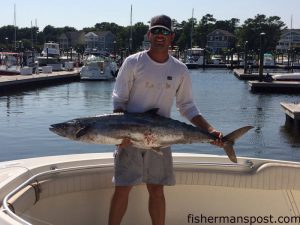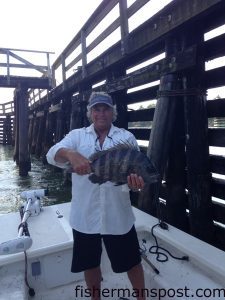Carolina Beach – July 10, 2014

Daniel Jeeves, of Leland, NC, with a red drum that struck a live finger mullet in Carolina Beach Inlet while he was fishing with Capt. Robert Schoonmaker of Carolina Explorer.
Kyle, of Island Tackle and Hardware, reports that the flounder bite seems to have gotten better since last week’s hurricane, and anglers are running into some fat flatfish throughout the area, with good action reported in Carolina Beach Inlet, the ICW, Snows Cut, and the Cape Fear River. Most are falling for live baits on Carolina rigs, but anglers working Gulps are hooking up as well.
Red drum are feeding in most of the same spots as the flatfish and in the bays off the lower Cape Fear River. They’ll bite live baits, too, but topwater plugs, soft plastics, and other artificials can be effective.
Speckled trout are feeding around the grass islands and structure in the Cape Fear River. Live shrimp fished under floats are tough to beat for the specks, but anglers can also tempt them to bite soft plastics and suspending hard baits.
Surf casters are hooking a typical summer mixed bag of bottomfish, and good numbers of large sharks have also shown up along the beachfront. The sharks will bite large cut and dead baits on fish finder rigs.
The spanish mackerel bite has slowed a bit since the storm, but anglers are already finding some along the beachfront again when they can find clean water. The action should improve as the ocean continues to settle. Clarkspoons trolled behind planers and torpedo sinkers are the way to go for the spaniards.
Some king mackerel have been feeding a bit further out, from the 5 mile range on offshore. Anglers can fool the kings with live baits (like menhaden) or dead cigar minnows and ballyhoo.
Dolphin had pushed into the 20-40 mile range before the blow, and they should be feeding in the same areas after. They’ll bite the same live and dead baits as the kings or a variety of artificials.
The few boats who went to the Gulf Stream last week reported more dolphin and some blackfin tuna action.
Robert, of Carolina Explorer, reports that all the rain that Hurricane Arthur dumped on the area moved the fish around a bit, but anglers have seen some decent action since the storm. Flounder and red drum are the main targets inshore right now. The reds are feeding in the bays and backwaters off the lower Cape Fear River and in the ICW and inlets. Live baits like finger mullet have produced the best results with the reds recently, but anglers are also hooking up while working topwater plugs, soft plastic baits, and other lures.
Flounder are feeding in the inlets and around structure in the ICW and Cape Fear River. Anglers are hooking a few while working soft plastic baits for the reds, but most are falling for live menhaden and finger mullet on Carolina rigs.
There was a decent speckled trout bite in the river before the storm, but it’s slowed down a bit. Anglers should be able to find some specks feeding around grass islands and oyster rocks in the area once the water cleans up a bit.
Dirty water has also slowed the flounder and spanish mackerel bite out in the ocean, but both should recover within the week. Trolling Clarkspoons around the inlets and along the beachfront is the way to connect with the spanish. Anglers can find the ocean flounder feeding around bottom structure and hook them on the same baits as the fish inshore.

Travis Overman,of Southport, with a 42 lb. king mackerel that bit a live bait near Frying Pan Tower while he was fishing with Tommy and Tom Rechichar.
Brenda, of Carolina Beach Pier, reports that bottom fishermen are hooking some croaker and sea mullet on shrimp.
Some fat flounder are falling for live baits fished under the pier.
Chris, of Kure Beach Pier, reports that anglers are hooking some flounder on live baits fished near the pilings.
Croaker and sea mullet are falling for bottom rigs baited with shrimp and bloodworms.

